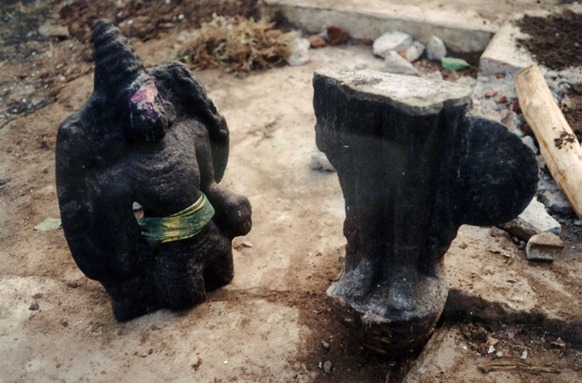 A Siva temple located at an ancient Hindu site called Akaththiyar Thaapanam, at Kangku-veali in the Moothoor division of the Trincomalee district, where Hindus gather especially to perform the Aadi Amaavaasai ritual for ancestors, was destroyed without any traces coinciding the Heroes’ Day on 27 November. The location of the temple is under the control of Sri Lanka Army stationed at a nearby Sinhala village, Neelaappola. The Sinhala villagers of Neelaappola protected the Tamil villagers of Kangku-veali from displacement in 2006. The Tamil villagers who were shocked and wept to see the temple wiped out, suspect ‘outsiders’ and are scared now whether this is a prelude to wipe out their traditional village as well.
A Siva temple located at an ancient Hindu site called Akaththiyar Thaapanam, at Kangku-veali in the Moothoor division of the Trincomalee district, where Hindus gather especially to perform the Aadi Amaavaasai ritual for ancestors, was destroyed without any traces coinciding the Heroes’ Day on 27 November. The location of the temple is under the control of Sri Lanka Army stationed at a nearby Sinhala village, Neelaappola. The Sinhala villagers of Neelaappola protected the Tamil villagers of Kangku-veali from displacement in 2006. The Tamil villagers who were shocked and wept to see the temple wiped out, suspect ‘outsiders’ and are scared now whether this is a prelude to wipe out their traditional village as well.
Moothoor (Mūtūr), spelt in a number of mutilated ways by the Sinhala and English media of the island, and copied by the international media, simply means ‘the ancient village’ in Tamil.
The Akaththiyar Thaapanam at Kangku-veali in Moothoor division is a site mentioned in a local mythological literature called Karaisaip-puraa’nam.
Akaththiyar Thaapanam means ‘the structure or deity installed by sage Agastiya’ of mythological fame in South India and Southeast Asia.
Local Tamils traditionally gather at this place to perform the annual Hindu ritual of Aadi Amaavaasai (the new moon of the Tamil month July-August) for ancestors.
Decades ago, a small temple was constructed at the ritual site by bringing the ancient sculptures of Sivalingam, Pi’l’lyaar and Murukan found in the adjacent ruins that still bear ancient pillars.
In 2006, when people of the traditional Tamil villages, Moothoor and Champoor were displaced, the famous ancient temple for Paththira-kaa’li at Champoor was destroyed.
Even during those precarious times the Tamil people of Kangku-veali didn’t evacuate. They in fact stayed with the people of the adjacent Sinhala village Neelaappola and were protected by them.
However, Tamils were not permitted by the SLA stationed at Neelaappola to perform Aadi Amaavaasai ritual this year.
In recent times local people witness outside Sinhalese visiting the locality for ‘tourism’ purposes, as the government has announced Tamil areas are now cleared for the Sinhalese to visit.
The Tamil villagers last saw the temple intact on 20th November. They first noticed the destruction on the 28th, suspect systematic State programme, and hence are afraid to complain about it to anyone.
A spontaneous development about Hinduism in the island is that in many rural areas people have started officiating rituals by themselves, as there are no Brahmin priests.
Those who witness the destruction of Hindu temples in recent times in Galle, Moothoor, Champoor and other places and prevention of Hindu festivals on many instances wonder at the irony of Sinhala leaders like Mahinda Rajapaksa and Ranil Wikramasinghe regularly visiting Hindu temples in South India to perform Brahmanic rituals to fulfil their power-greedy desires.
While Tamils of Champoor find their Paththira-kaa’li temple destroyed, a strong folk belief currently circulating among the Sinhalese in the South is that Mahinda was able to win the war only because of the Malayala Kaddaadiyas (sorcerers from Kerala) hired by him to perform a dreaded ‘Kaa’li Bandhana’ (binding the worrier goddess Kaa’li), propitiating the Hindu deity for his victory.
The Sinhala word Kaddaadiyaa (Kaṭṭāṭiyā) that means a sorcerer, enchanter, magician, devil priest, shaman priest or dancer itself is an old Tamil word that originally meant a stage-performer (Kaddu-aadi: one who dances or performs on stage or enclosure).
(For updates you can share with your friends, follow TNN on Facebook and Twitter )
